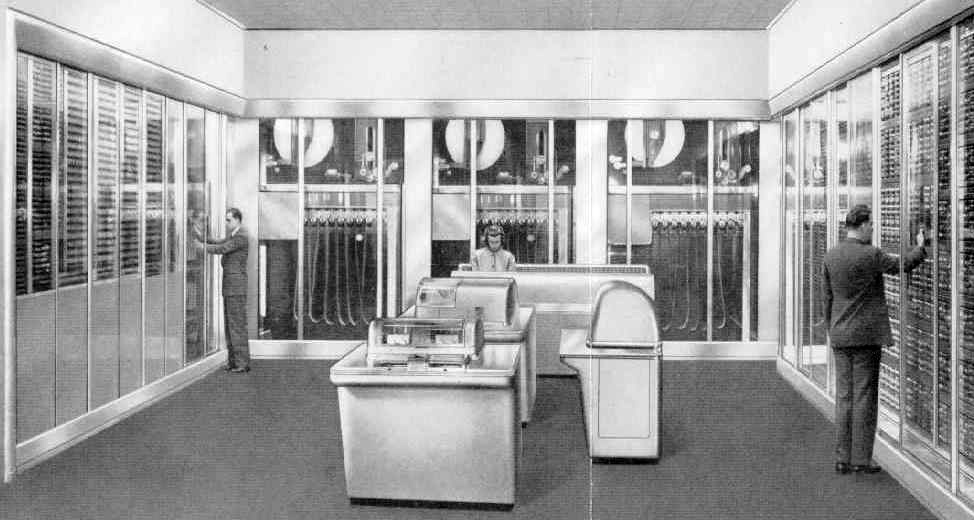The IBM Selective Sequence Electronic Calculator
Frank da CruzIBM's Selective Sequence Electronic Calculator (SSEC), built at IBM's Endicott facility under the direction of Columbia Professor Wallace Eckert and his Watson Scientific Computing Laboratory staff in 1946-47, shown here after it was moved to the new IBM Headquarters Building at 590 Madison Avenue in Manhattan [4], where it occupied the periphery of a room 60 feet long and 30 feet wide [42] (Herb Grosch [59] estimates the dimensions of its "U" shape at 60 + 40 + 80 feet, 180 feet in all, about half a football field!)
fdc@columbia.edu
May 2003
Last update: 22 September 2023
Visible along the wall in the background are three punches and thirty readers that form the paper-tape storage, with a large roll of tape above each punch. The paper tape was actually uncut IBM card stock, more than seven inches wide, weighing 400 pounds per roll [57, 59] (CLOSEUP). Along the left wall are banks of vacuum tube circuits for card reading and sequence control and 36 paper tape readers comprising the table-lookup section, many of them loaded with custom tape loops for commonly referenced data. Most of the panels along the right wall are occupied by the electronic arithmetic unit and storage. In the center of the room: card readers, card punches, printers, and (not visible) the operator's console.
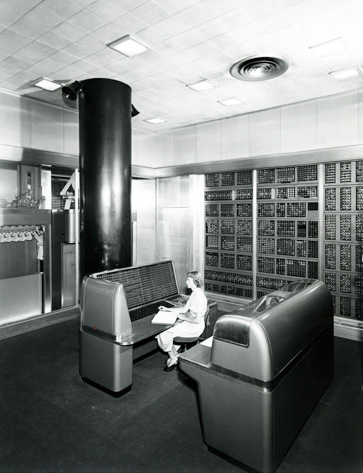 "Designed, built, and placed in operation in only two years, the SSEC
contained 21,400 relays and 12,500 vacuum tubes. It could operate
indefinitely under control of its modifiable program. On the average, it
performed 14-by-14 decimal multiplication in one-fiftieth of a second,
division in one-thirtieth of a second, and addition or subtraction on
ninteen-digit numbers in one-thirty-five-hundredth of second... For more than
four years, the SSEC fulfilled the wish Watson had expressed at its
dedication: that it would serve humanity by solving important problems of
science. It enabled Wallace Eckert to publish a lunar ephemeris ... of
greater accuracy than previously available... the source of data used in man's
first landing on the moon" [4].
"For each position of the moon, the operations required for calculating and
checking results totaled 11,000 additions and subtractions, 9,000
multiplications, and 2,000 table look-ups. Each equation to be solved
required the evaluation of about 1,600 terms — altogether an impressive
amount of arithmetic which the SSEC could polish off in seven minutes for the
benefit of the spectators" [9].
"Designed, built, and placed in operation in only two years, the SSEC
contained 21,400 relays and 12,500 vacuum tubes. It could operate
indefinitely under control of its modifiable program. On the average, it
performed 14-by-14 decimal multiplication in one-fiftieth of a second,
division in one-thirtieth of a second, and addition or subtraction on
ninteen-digit numbers in one-thirty-five-hundredth of second... For more than
four years, the SSEC fulfilled the wish Watson had expressed at its
dedication: that it would serve humanity by solving important problems of
science. It enabled Wallace Eckert to publish a lunar ephemeris ... of
greater accuracy than previously available... the source of data used in man's
first landing on the moon" [4].
"For each position of the moon, the operations required for calculating and
checking results totaled 11,000 additions and subtractions, 9,000
multiplications, and 2,000 table look-ups. Each equation to be solved
required the evaluation of about 1,600 terms — altogether an impressive
amount of arithmetic which the SSEC could polish off in seven minutes for the
benefit of the spectators" [9].
 Control is accomplished by means of written instructions,
which the machine reads and follows. Typical commands are:
• "Read a number from one of the reading units and store it in
a given memory unit"; • "Take the number from a given
memory unit, multiply it by the one in another unit, drop a specified number
of digits from the answer, and deposit it in a third
unit." [83].
Control is accomplished by means of written instructions,
which the machine reads and follows. Typical commands are:
• "Read a number from one of the reading units and store it in
a given memory unit"; • "Take the number from a given
memory unit, multiply it by the one in another unit, drop a specified number
of digits from the answer, and deposit it in a third
unit." [83].
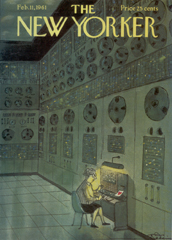 The SSEC was visible to pedestrians on the sidewalk, and inspired a
generation of cartoonists to portray the computer as a series of
wall-sized panels covered with lights, meters, dials, switches, and spinning
rolls of tape (click image to enlarge). The SSEC ran at this
location from January 1948 to July 1952, when it was replaced by the
first-off-the-line 701, IBM's first "mass"-produced
computer (i.e. more than one).
The SSEC was visible to pedestrians on the sidewalk, and inspired a
generation of cartoonists to portray the computer as a series of
wall-sized panels covered with lights, meters, dials, switches, and spinning
rolls of tape (click image to enlarge). The SSEC ran at this
location from January 1948 to July 1952, when it was replaced by the
first-off-the-line 701, IBM's first "mass"-produced
computer (i.e. more than one).
 At the SSEC opening ceremony, 27 January 1948,
Betsy Stewart [57] at the SSEC operator
console. From left, standing behind the console: Robert R. "Rex" Seeber (SSEC
chief architect) Columbia professor Wallace J. Eckert (project director),
Thomas J. Watson (IBM president), and Frank E. Hamilton (chief
engineer) [42].
At the SSEC opening ceremony, 27 January 1948,
Betsy Stewart [57] at the SSEC operator
console. From left, standing behind the console: Robert R. "Rex" Seeber (SSEC
chief architect) Columbia professor Wallace J. Eckert (project director),
Thomas J. Watson (IBM president), and Frank E. Hamilton (chief
engineer) [42].
|
Here's a view of the SSEC from the brochure given out at the opening ceremony, courtesy Herb Grosch:
"[Above is] the famous retouched photo of [the SSEC room]: Bill McClelland at the table-lookup unit [left], Betsy Stewart at the console, an engineer on the right. NO columns" [59]. CLICK HERE for an unretouched view.
Watson Senior, upon first viewing SSEC prior to the public unveiling: "There is just one thing," he said somewhat off-handedly. "The sweep of this room is hindered by those large black columns down the center. Have them removed before the ceremony." But since they supported the building, the columns stayed. Instead, the photo in the brochure handed out at the ceremony was carefully retouched to remove all traces of the offending columns [57].
 Here are some additional images from Eckert's 1948 Scientific
Monthly article [83] (click on each image
for detail):
Here are some additional images from Eckert's 1948 Scientific
Monthly article [83] (click on each image
for detail):

|
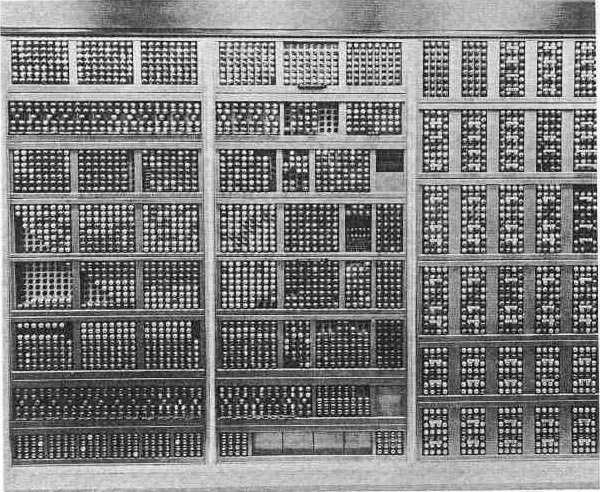
|
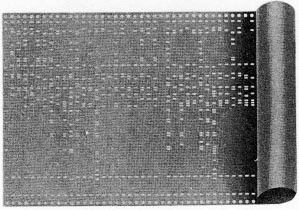
|
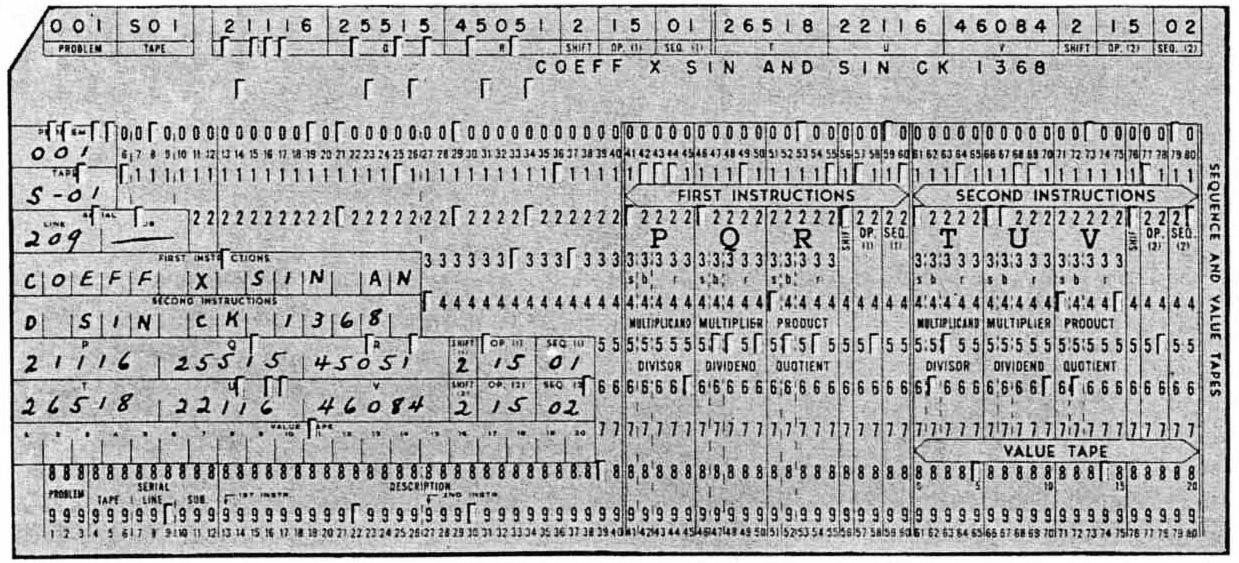
|
And here are scans of two glass slides unearthed by Herb Grosch in April 2004 (click images for detail):
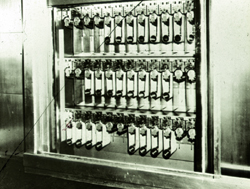
|
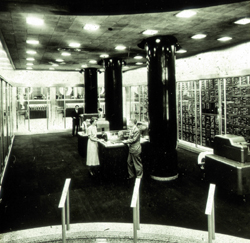
|
Watson-signature plaque attached high on the limestone "frame" to the
extreme right [59] (not visible in photo):
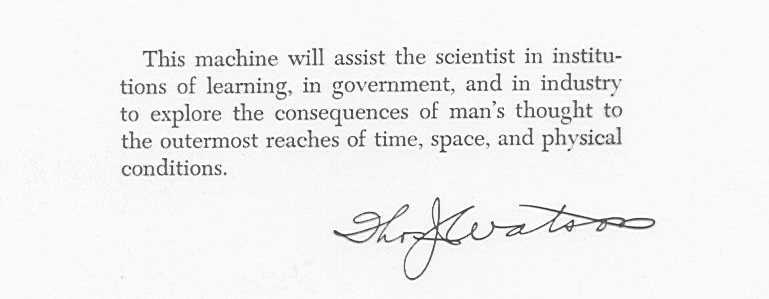
From a biography of John Backus, who was later to develop FORTRAN (among many other contributions):
During that spring [1949], Backus visited the IBM Computer Center on Madison Avenue, where he toured the Selective Sequence Electronic Calculator (SSEC), one of IBM's early electronic computers. While on the tour, Backus mentioned to the guide that he was looking for a job. She encouraged him to talk to the director of the project, and he was hired to work on the SSEC.The SSEC was not a computer in the modern sense. It had no memory for software storage, and programs had to be entered on punched paper tape. It had thousands of electromechanical parts, making it unreliable and slow as well. Part of Backus's job was to attend the machine, and fix it when it would stop running. Programming the SSEC was also a challenge, as there was no set way of doing it.
Backus spent three years working on the SSEC, during which time he invented a program called Speedcoding. The program was the first to include a scaling factor, which allowed both large and small numbers to be easily stored and manipulated.
The SSEC was used for a variety of large-scale scientific calculations, including by Columbia Professors Eckert (astronomy), Thomas (physics), and Grosch (optics), all of Watson Lab. It was also the focus of one of the world's first Computer Science courses, offered beginning in 1946; here's the listing from a 1951 Columbia course catalog:
Astronomy 111 — Machine methods of scientific calculation, I.
2 to 4 points Winter Session. Dr. ECKERT and assistants.
M. 2:10-3.
Laboratory hours to be arranged.
The use of modern calculating machines in scientific research: keyboard calculators,
punched-card equipment, relay and electronic calculators, non-digital machines. Lectures,
demonstrations and laboratory work.
Prerequisite or parallel: Engineering 281, and at least one other course listed in this
Announcement, or an equivalent. Permission of instructor required.Astronomy 112 — Machine methods of scientific calculation, II.
2 to 4 points Spring Session. Mr. SEEBER.
Hours to be arranged.
This course deals primarily with the Selective Sequence Electronic Calculator;
organization of the machine and the preparation of problems for it.
Prerequisite: Astronomy 111,
The following photos are from a November 1952 article in Chemical Engineering describing L.H. Thomas's solution, on the SSEC, of the then-64-year-old problem of the stability of plane Poiseuille flow, based on an analytical solution to the problem suggested by John von Neumann, and programmed by Phyllis K. Brown and Donald A. Quarles, Jr., of Watson Lab. The calculation took 150 hours, compared to the 100 years that would have been needed for hand computation.
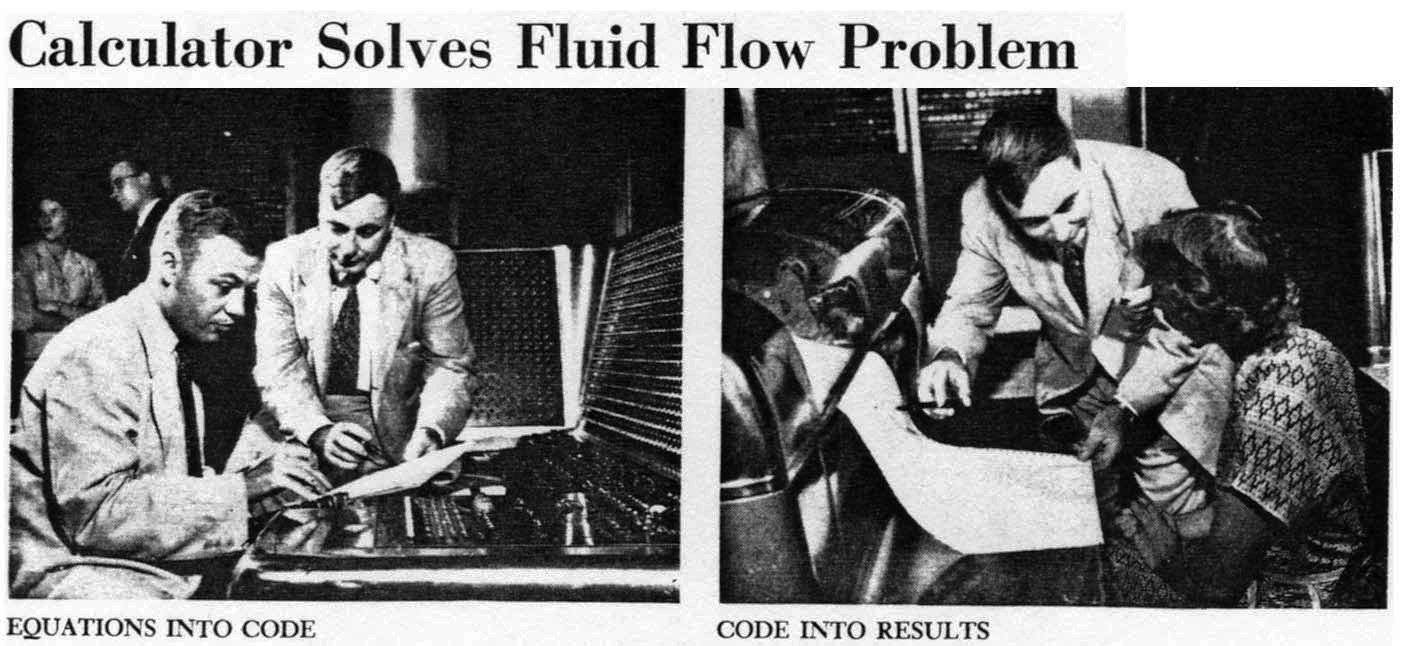 Pictured: Don Quarles (seated),
L.H. Thomas (hovering), Phyllis Brown (seated).
Pictured: Don Quarles (seated),
L.H. Thomas (hovering), Phyllis Brown (seated).
Was the SSEC the First Stored-Program Computer?
The SSEC is often excluded from consideration as the first computer, or the first stored-program computer, because IBM did not call it a computer. According to Bashe [4,p.143] this was because Thomas J. Watson did not want to give the impression that he was building devices that would put people (human computers) out of work! (In 1951, in a series of five lectures about the new machines broadcast on the BBC, four of them used the term "automatic calculating machine"; only one, by Alan Turing, used the term "digital computer" [Jones reference below].)Cambridge University's EDSAC (1949) or Manchester University's Baby (also 1949) are commonly cited as the first stored-program computers; that is, computers that could be controlled from a program stored in main random-access memory. But if SSEC was also a stored-program computer, it predated EDSAC by a year. Opinions differ as to its qualifications. In his 1958 Encyclopedia Americana article, Wallace Eckert said the SSEC "combined electronic speed of operation with large storage capacity (nearly a million digits principally in serial form) and facilities for completely flexible stored-program control. The random-access storage was on electromagnetic relays and the serial storage on very high-speed paper tapes. The calculator solved many large problems in celestial mechanics, hydrodynamics, geophysics, and atomic theory" [81]. Different authors voice different opinions. In fact, the SSEC was a hybrid device, capable of executing instructions from paper tape or storing them into its (admittedly rather small) relay memory and executing them from there; when doing that, it fit the definition of "von Neumann architecture". If von Neumann architecture is a critical element of the definition of "computer", then arguably the SSEC might be considered the world's first computer, even if it was also (as some say), a "bizarre hybrid incorporating vacuum tubes, relays, and paper-tape reader-punches" or a "giant publicity stunt of a machine". Proponents of the SSEC-as-first-computer view include Emerson Pugh [40] (computer historian), R. Morceau (1981 book, GET REFERENCE), as well as numerous computer-history websites. The abstract to Bashe's 1982 Annals article (see References just below) states:
The Selective Sequence Electronic Calculator (SSEC) was the first machine to combine electronic computation with a stored program, and the first machine capable of operating on its own instructions as data. When placed in operation in 1948, and for some time thereafter, it was the most flexible and powerful computer in existence. IBM published relatively little about it, and the SSEC has been largely overlooked by computer historians. This paper provides a historical setting for the SSEC.
John Backus [102] told me “I think it's an extreme stretch to consider it the first ‘stored program’ computer--even though one of the programs I did used some specially prepared storage cells as the source of an instruction after some data was stored in it.” On the other hand, the SSEC's chief design engineer, A. Wayne Brooke, claimed (e.g. in his unpublished book manuscript, SSEC, The First Electronic Computer) that the SSEC was the first electronic computer because of its stored-memory capacity. In April 2019, John Savard added:
As noted, the SSEC possessed several types of memory. It had a paper tape which could be punched and re-read for intermediate results of calculations. It had eight registers built from vacuum-tube flip-flops. Neither of those seems like a promising place to put a stored program.But it also had 150 locations of relay memory. While setting locations in that memory is an electromechanical operation, detecting whether a current passes through a relay would not seem to involve such delays. Could placing a short loop in the relay memory allow the SSEC to operate at electronic speeds? Alas, not. Lacking anything similar to the coincident-current principle of core memory, the large number of locations in relay memory meant that its addressing also had to be done with relay logic, and thus reading a number, or instruction, from relay memory took 20 milliseconds, the same time as it took to read a number from paper tape (W. J. Eckert, "Electrons and Computation"[83]).
John also noted that "IBM's Early Computers"[4] yields that the program with which the SSEC was first demonstrated determined the sine of an angle by using an instruction that was modified; the reference is given as Phelps, 1980: apparently an interview.
- McPherson, John, "A Large-Scale, General-Purpose Electronic Digital Calculator--the SSEC" (1948), IEEE Annals of the History of Computing, Vol.4 No.4 (Oct 1984), pp.313-326.
- Bashe [4], Pugh [40], and Brennan [9].
- Bashe, C.J., "The SSEC in Historical Perspective", IEEE Annals of the History of Computing, Vol.4 No.4, pp.296-312 (1982).
- The IBM Selective Sequence Calculator, IBM Form 52-3927-0, New York (1948), 16pp.
- Grosch, Herbert R.J., Computer: Bit Slices from a Life, Third Millenium Books, Novato CA (1991) [57].
- Eckert, W.J., "Electrons and Computation", The Scientific Monthly, Vol. LXVII, No. 5 (Nov 1948).
- Polachek, Harry, "Computation of Shock Wave Refraction on the Selective Sequence Electronic Calculator", Proceedings, Scientific Computation Forum, IBM, New York (1948), pp.107-122.
- Anderson, Dan, "Mathematics in Electronic Age - IBM's Lightning Calculator Will Do Everything Except Percolate Coffee", New York Sun, Wendesday, January 28, 1948.
- Jones, Allan, "Five 1951 BBC Broadcasts on Automatic Calculating Machines", IEEE Annals of the History of Computing, Vol.26 No.2, pp.3-15 (2004).
- Jones, Steven E, Roberto Busa, S.J., and the Emergence of Humanities Computing: The Priest and the Punched Card, Routledge (2016). Includes chapter on the SSEC.
- Olley, Allan, "Existence Precedes Essence - Meaning of the
Stored-Program Concept", IHPST, University of Toronto: IFIP Advances in
Information and Communication Technology 325, ISSN 1868-4238 (2010),
Springer, Boston, pp.169-178:
"The SSEC stored instructions and data in the same format, could automatically manipulate instructions and used this feature to vary operation in response to intermediate results. Therefore the SSEC embodied the narrow denition of a stored program computer. Yet this feature often went unmentioned even in accounts that emphasized the narrow denition of the stored-program computer as a, or the, key element of the modern computer ... The SSEC's use of relays for the bulk of its 'fast' memory meant that its operating speeds were somewhat limited compared to later machines and even the earlier ENIAC."
- Arctander, Eric, "Trig Homework? Consult Watson Computing Labs", Columbia Spectator, 18 October, 1948, page 8.
- "Latest Electronic Brain Calculates; Plays Chess", Columbia Spectator, 22 February 1951, page 8.
- John Backus.
- Grosch [57], Chapter 01.
- SSEC Reunion 1972 (raw material).
- John Savard, The Selective Sequence Electronic Calculator (section of The Old Days: Computing Without RAM.
- IBM through the years - 1948 (IBM)
- John Backus Biography, thocp.net: The History of Computing Project
- Color Photo of SSEC Control Desk (IBM)
- The IBM 701 that replaced the SSEC at IBM World HQ.
- Computer Pioneers Part 1: The Dawn of Electronic Computing, 1935-1945, a Computer History Museum film. Minutes 42-50, consisting mainly of a talk by Herb Grosch, concern Watson Lab, Wallace Eckert, and the SSEC, with some short film clips of the SSEC towards the end. Allan Olley says, “There is one obvious gaff in the SSEC section where they give the number of decimal digits in the relay store as 300 instead of 3000 (well actually 2850 but they give the vaccuum tube storage as 160 so they were clearly counting the sign as a digit). Also Bell repeats the false story that the CPC was somehow a commercial version of the SSEC.”
- Walk East On Beacon (1952), a Hollywood noir film featuring about a minute of footage of the SSEC.
- Olley, Allan, The SSEC First Electronic Machine on the Silver Screen, IT History Society, 1 January 2015.
- Screen shots of the SSEC from Walk East on Beacon at Starring the Computer.
- SSEC video clip from Walk East on Beacon (1 minute, 26 seconds).
- Gil Press, "This Day In Data: From the Apple Macintosh To The iPhone and AI in China", Forbes Magazine, 22 January 2019.
- McNeill, Leila,
How
Margaret Dayhoff Brought Modern Computing to Biology,
Smithsonian Magazine, 9 April 2019:
"Columbia was a hotbed for computing technology. It boasted some of the first computing laboratories in the U.S., and in 1945 became home to the IBM Watson Scientific Laboratory led by astronomer W. J. Eckert. The Watson lab had first served as a computing center for the Allies in the final months of WWII. After the war, it became a site for developing some of the first super computers, including the Selective Sequence Electronic Calculator (SSEC), which Eckert later used to calculate lunar orbits for the Apollo missions. With this technology at her fingertips, Dayhoff combined her interest in chemistry with computing by way of punched-card machines — essentially early digital computers. The machines allowed Dayhoff to automate her calculations, storing an algorithm on one set of cards and data on another. Using the machine, she was able to process calculations far more quickly and accurately than by hand."
- A. Wayne Brooke Papers 1948-1986, MC 00268, Boxes 1-3, Special Collections Research Center, North Carolina State University Libraries, Raleigh NC. "Focuses on the Selective Sequence Electronic Calculator (SSEC) at International Business Machines Inc. (IBM) and the history of computing... Brooke joined IBM soon after the war, and his early career at IBM was wholly involved with the Selective Sequence Electronic Calculator (SSEC) in the world headquarters of IBM in New York City. Brooke was the chief electronic engineer for the project and oversaw a team of engineers during the short life of the SSEC ... It has been argued, by Brooke in particular, that the SSEC was the first electronic computer because of its unique stored-memory capacity."
- Baker, Jennifer, "The SSEC: IBM's 'Electronic Brain' and Reaching the Moon", NCSU Libraries News (undated).
- Marian Taylor Antin obiturary, The Gazette, 15 January 2023: "She worked in various positions, first as an assistant preschool teacher, eventually taking a position with IBM as a tour guide of the Selective Sequence Electronic Calculator, one of the first modern computers."
Translations of this page courtesy of...
| Language | Link | Date | Translator | Organization |
|---|---|---|---|---|
| Albanian | Shqip | 2023/08/31 | Kerstin Schmidt | https://admission-writer.com/ |
| Belarusian | Беларускі | 2023/08/17 | Vladyslav Byshuk | Владислав Бишук | studycrumb.com |
| Bulgarian | български | 2023/08/31 | Kerstin Schmidt | https://prothesiswriter.com/ |
| Estonian | Eesti | 2023/08/31 | Kerstin Schmidt | https://justdomyhomework.com/ |
| Farsi | فارسی | 2019/02/04 | Anonymous | 3 Piece Wall Art |
| French | Français | 2019/02/04 | Anonymous | Hootsuite Login |
| German | Deutsch | 2019/02/07 | Anonymous | Word Art America |
| Greek | Ελληνικά | 2019/02/08 | Anonymous | Canvas Prints Brisbane |
| Hebrew | עִברִית | 2019/02/08 | Anonymous | Canvas Prints Sydney |
| Hungarian | Magyar | 2023/08/31 | Kerstin Schmidt | https://pro-academic-writers.com/ |
| Italian | Italiano | 2019/02/08 | Anonymous | Personalized Soundwave Art |
| Lithuanian | Lietuvių | 2023/08/31 | Kerstin Schmidt | https://writemyessay4me.org/ |
| Norwegian | Norsk | 2022/05/25 | Rune | Bildeler på nett |
| Polish | Polski | 2019/02/04 | Anonymous | Word Art Sydney |
| Romanian | Română | 2023/08/17 | Vladyslav Byshuk | Владислав Бишук | studybounty.com |
| Russian | Русский | 2019/11/04 | Anna Clarke | Essay Writing Services |
| Serbian | Српски | 2019/03/13 | Бранка Фиагић / Branca Fiagić | Универзитет у Београду / University of Belgrade |
| Slovenian | Slovenščina | 2019/03/27 | Andrijana Savicević | Univerzitet u Beogradu / University of Belgrade |
| Spanish | Español | 2019/02/08 | Anonymous | Gustav Klimt Prints |
| Swedish | Svenska | 2023/08/31 | Kerstin Schmidt | https://writemypaper4me.org/ |
| Ukrainian | Українська | 2023/08/17 | Vladyslav Byshuk | Владислав Бишук | skyclinic.ua |

